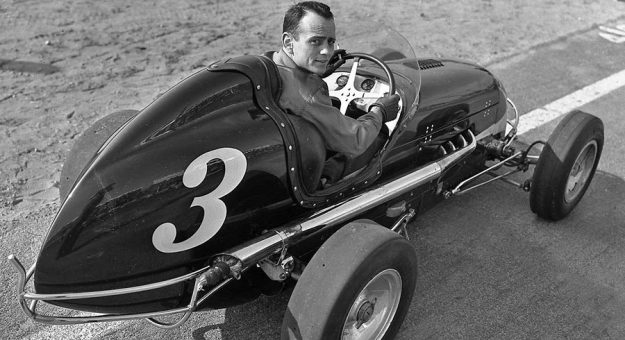“There were eight of us in a 1941 Buick with the midget behind us on a trailer, all the way to California in Feb. 1941, 3,000 miles in seven days,” said 89-year-old Mike Caruso Jr., now of Las Vegas, recalling the journey. “My father and Ted Tappett were up front. Ted was driving on Route 66 in Arizona when he got a speeding ticket. We made it to Los Angeles, stayed in a really nice motel, worked on the car at Curly Wetteroth’s shop. I was 9 and my father had me pick pieces of a broken pinion gear out of the rear end at the shop, and he introduced me to this guy with a mustache and told me to never forget him, that he was a great race driver. It was Leon Duray.”
Walters’ wartime service earned him the Bronze Star and he returned home to resume his career as Tappett, running midget events from the Buffalo Municipal Stadium to Freeport and Islip on Long Island, to the Kingsbridge Armory in the Bronx, to West Springfield, Mass.; Danbury, Conn.; and around the historic Negro League ballfield at Hinchliffe Stadium in Paterson, N.J.
The post-war, passing-free speed parades of Offy-powered Kurtis midgets caused houses to drop and promoters to pivot toward cheaper, more contact-friendly stock cars.
Still as Tappett, he raced at tiny Riverside Park Speedway in Agawam, Mass., in 1949, the first year it ran stockers as its lead division. Tappett copped 14 features that year, a record that still stood when Riverside Park closed in 1999.
It was around this time when Walters became close to Bill Frick, a veteran Long Island owner of midgets and stock cars. They started Frick-Tappett Motors, which specialized in squeezing the new, revolutionary Cadillac overhead-valve V-8 into equally new 1949-and-up Ford coupes, creating a car called the Fordillac.
It was strongly popular with denizens of the rapidly growing performance scene on Long Island, numbering many aeronautical technicians and engineers who worked at the aircraft plants that dotted the island. As lore has it, Walters drove a Fordillac to Watkins Glen, N.Y., where several Long Island racers were running early, organized road races through the village streets.
Several racers liked the Fordillac. One of them was Cunningham, heir to the Swift meatpacking fortune, whose own race car was a home-crafted Mercedes-Benz SSK roadster on a Buick Century straight-eight chassis.
Walters indeed sold a Fordillac to Cunningham. He and Frick dropped a Cadillac V-8 into Cunningham’s Healey Silverstone that they modified with a homebrew de Dion independent rear cobbled from castoff American parts, including Jeep hubs. Walters, his Tappett nickname retired, took it to his first road-course victory at Watkins Glen during the 1950 Seneca Cup.
After a noteworthy debut at Le Mans that year with a pair of production-based Cadillacs, Cunningham hired Walters and Frick to run his BS Cunningham Co. in West Palm Beach, Fla., which began designing racing sports cars around new Chrysler Hemi engines. Walters’ personal fastidiousness and obvious talent in the seat resonated with his wealthy patron.
“I remember that whenever Ted Tappett would sit down anywhere, even on a tire, he would first take a rag and wipe it down,” said New Jersey team owner Ken Brenn. “He was so clean it was unbelievable, and he was a very good, calculating driver, very smooth, very disciplined. Guys who ran midgets back then ran a lot of races. All you have to do is look at Kyle Larson to know what a midget can turn you into.”
In Walters’ case, that transition led to unquestioned international stardom, although driving became secondary to his role in designing and fabricating several evolutions of the Cunningham sports racers during the 1950s. In those, and a succession of other sports cars, Walters won SCCA National meets, including three at Watkins Glen, making him the only driver to win on the village streets and the subsequent permanent course.
Walters had two Le Mans podiums, the last in 1953, and won the 12 Hours of Sebring twice for Cunningham, once aboard a Cunningham in 1953 with his fellow ex-POW John Fitch, and again in 1955 teamed with future F-1 world champion Mike Hawthorn while sharing Cunningham’s Jaguar D-Type. Months later, Hawthorn’s swerve triggered the Le Mans disaster. When his own D-Type swallowed a throttle venturi, Walters left auto racing for good.
Walters later co-owned a Volkswagen, Audi and Porsche dealership in Hicksville, N.Y. — started with an assist from U.S. Ferrari distributor Luigi Chinetti — and pursued competitive sailing, which was still a passion when he died in 2000.
“I’m one of six children, and when he quit driving, we were getting our shots lined up so we could move to Italy when he started driving for Ferrari,” his son, also named Phil Walters, recalled. “After Le Mans, he decided he didn’t want to be part of it. He never mentioned that he regretted the decision, although he did mention once that if he had a little practice, he probably could have gotten right back into it.”
